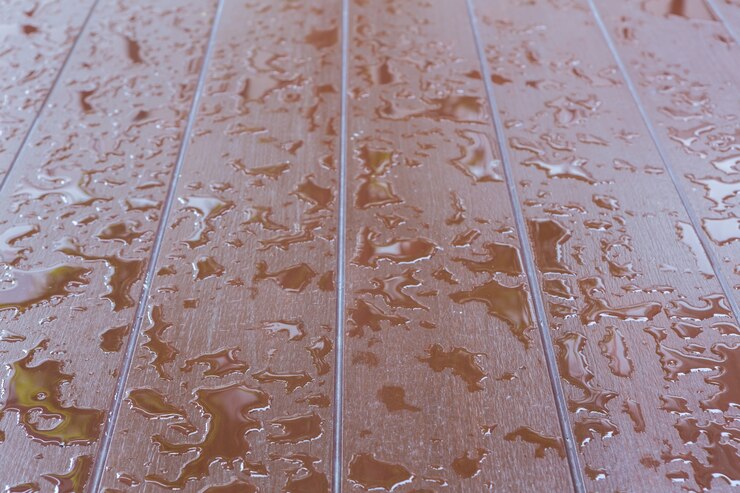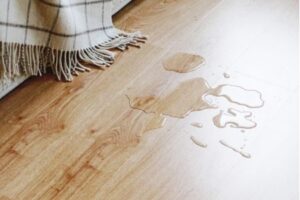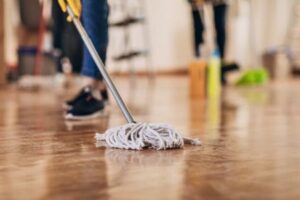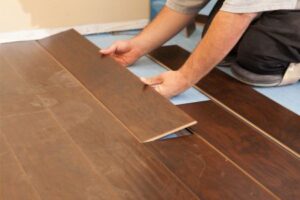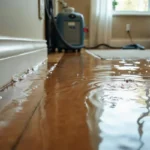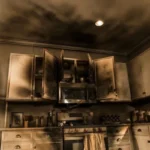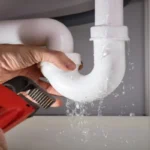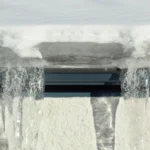Water damage to laminate flooring can lead to visible issues such as warping, bubbling, and discoloration. While laminate flooring is designed to resist minor spills and moisture exposure, it is not fully waterproof. It is made to resist small amounts of water and give some time to clean up spills before damage occurs. However, standing water and large amounts of water can still cause damage and lead to homeowners needing water restoration services.
The planks can absorb water, swell, and lose structural integrity when exposed to standing water or excessive moisture for an extended period. If the damage is not addressed promptly, it can become permanent, requiring extensive repairs or a complete floor replacement.
However, in some cases, you may be able to salvage water-damaged laminate flooring by taking immediate action to dry the affected areas and prevent further deterioration. This guide will help you determine if your laminate flooring can be saved, outline the steps to repair minor water damage, and provide tips on preventing future water issues.
Signs of Water Damage on Laminate Flooring
Before deciding whether to repair or replace your laminate flooring, you need to assess the extent of the water damage. Consulting with water restoration service providers can help you understand the extent of your issues. In the meantime, here are the most common signs to look for:
- Warping or Buckling – Laminate planks may expand and warp, causing uneven surfaces or raised edges.
- Discoloration or Stains – Water damage can lead to dark spots or patches that are difficult to clean.
- Cupping or Crooked Planks – If moisture seeps into the core of the planks, they may curve, creating an uneven floor.
- Mold or Mildew Growth – A musty odor or visible mold growth indicates prolonged exposure to moisture.
- Cracks or Splitting – Moisture can weaken laminate planks, leading to cracks or split seams and planks.
- Bubbling or Blistering – Trapped moisture under the laminate surface can create raised bubbles or blisters.
If you notice these signs, you must quickly minimize damage and prevent further issues.
Assessing the Laminate Floor Water Damage
Assessing water damage to laminate flooring involves closely inspecting the affected areas for signs such as warping, discoloration, or bubbling. Start by checking for visible moisture or pooling water, particularly along the seams and edges of the planks. You should also look for any signs of mold or mildew growth, which can indicate prolonged exposure to water.
Gently press the surface to check for any softness or give, which may suggest the laminate has absorbed significant moisture. If the damage is localized and minimal, drying the area quickly may prevent further issues. However, for extensive damage or structural concerns, it is essential to consider professional assessment and repair.
Types of Water Damage to Laminate Flooring
Minor Water Damage
Minor water damage to laminate flooring typically involves small spills or moisture exposure that have not been left for long periods. This can result in slight warping or surface stains, but the floor’s structural integrity usually remains intact. Quick cleanup with a cloth or towel can prevent further damage. If addressed immediately, minor water damage often does not require any significant repairs, and the laminate can return to its original condition.
Moderate Water Damage
Moderate water damage occurs when laminate flooring has been exposed to more significant moisture, such as from a small leak or flooding that has not been cleaned up quickly. This can lead to visible warping, slight bubbling, or discoloration of the laminate surface. If not addressed quickly, this damage can spread across a larger area, potentially compromising the floor’s stability. Depending on the severity, you may need to replace specific planks or sections of the flooring.
Major Water Damage
Significant water damage happens when laminate flooring is subjected to extensive flooding or prolonged moisture exposure, often from a burst pipe or a basement flood. This type of damage causes significant warping, buckling, and separation of the laminate planks. The floor may also develop mold or mildew underneath, leading to an unpleasant odor and potential health concerns. Major water damage typically requires fully replacing the affected laminate sections or even the entire floor to restore its functionality and appearance.
If your flooring is not laminate but rather hardwood, the restoration process differs. Learn how to restore water-damaged hardwood floors step by step.
Water Restoration Service: Steps to Dry & Salvage Laminate Floors
If your laminate flooring has sustained minor to moderate water damage, you may be able to save it by following these steps:
1. Remove Standing Water Immediately
Use a mop, towels, or a wet/dry vacuum to remove any standing water as quickly as possible. The longer water sits on the laminate surface, the more likely it is to seep into the planks and cause swelling.
2. Increase Air Circulation
Set up fans, open windows, and use dehumidifiers to help dry the affected area faster. Placing box fans or industrial air movers in the room can help evaporate moisture trapped beneath the planks.
3. Remove and Inspect Damaged Planks
Carefully lift any planks that appear swollen or warped. Check the subfloor underneath for moisture. If the subfloor is damp, allow it to dry completely before reinstalling or replacing planks.
4. Dry the Subfloor
If water has seeped beneath the laminate, thoroughly dry the subfloor using fans, dehumidifiers, and heat sources. If mold or mildew is present, disinfect the area with a mild bleach solution or commercial mold remover.
5. Replace or Repair Planks
If the planks have only minor damage, try drying them and reinstalling them. For those that are severely damaged, replace them. Finally, ensure the locking system of the laminate planks remains intact when reinstalling them.
6. Seal and Protect
Once the damaged planks are repaired or replaced, apply a waterproof sealant along the seams to prevent future moisture penetration. This will provide an additional layer of protection and guard against future water damage.
When to Replace vs. Repair Laminate Flooring
Deciding whether to repair or replace laminate flooring depends on the severity of the damage. Here are some guidelines that professional water restoration service providers recommend:
- Repair the flooring if:
- Water exposure was brief, and the planks showed minimal swelling or discoloration.
- Only a few planks are affected and can be removed and replaced without disturbing the entire floor.
- The subfloor is dry, with no signs of mold or mildew.
- Replace the flooring if:
- Water has soaked into multiple planks, causing widespread swelling and warping.
- The floor has developed mold or mildew underneath, posing health risks.
- The planks have buckled, separated, or cannot be adequately reinstalled.
- The subfloor has sustained water damage, making repairs ineffective.
If unsure, consider hiring a professional to assess the extent of the damage and recommend the best course of action.
Preventative Measures to Protect Laminate Floors
To reduce the risk of water damage in the future, follow these preventative measures:
- Use Waterproof Mats & Rugs: Place mats near sinks, entrances, and high-moisture areas to absorb spills.
- Clean Spills Immediately: Even small spills can seep into seams if left unattended.
- Improve Room Ventilation: Use exhaust fans and dehumidifiers in bathrooms, kitchens, and basements.
- Install a Moisture Barrier: If installing laminate in moisture-prone areas, add an underlayment that resists water.
- Monitor Plumbing Fixtures: Check pipes, dishwashers, and refrigerators for leaks.
- Use Sealants: Apply a waterproof sealant to seams and edges for extra protection.
Taking these precautions can help extend the lifespan of your laminate flooring and prevent costly repairs.
Professional Intervention
Professional intervention may be necessary if the damage is widespread or involves mold. Water restoration specialists have the equipment and expertise to handle significant water damage. They can assess the extent of the damage, remove mold, and ensure proper subfloor drying. In cases of severe damage or when you are unsure about the condition of the laminate or subfloor, hiring a professional will help ensure the problem is handled correctly, preventing future damage.
Final Thoughts
Water-damaged laminate flooring can sometimes be saved if addressed quickly and appropriately. Removing standing water, increasing air circulation, and replacing affected planks are key steps in preventing further damage. However, a full replacement may be necessary if the flooring has severe warping, mold growth, or extensive damage.
Implementing preventative measures such as moisture barriers, proper ventilation, and quick spill cleanups can help protect your laminate floors from future water-related issues. If you’re unsure about the extent of the damage or need expert guidance, don’t wait—contact SS Water Restoration today for a professional inspection and fast, reliable solutions to restore your floors and protect your home.

